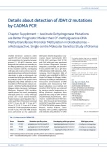Details about detection of IDH1/2 mutations by CADMA PCR
Chapter Supplement – Isocitrate Dehydrogenase Mutations are Better Prognostic Marker than O6-methylguanine-DNA Methyltransferase Promoter Methylation in Glioblastomas – a Retrospective, Single-centre Molecular Genetics Study of Gliomas
Published in the journal:
Klin Onkol 2017; 30(Online only): 1-2
doi:
https://doi.org/10.14735/amko20171
CADMA detection combines allele specific PCR with intended mismatch and competition for template between primers [1]. All qPCR reactions were designed and carried out according to the MIQE guidelines [2]. IDH1 R132H and R132C mutation specific, overlapping wild-type and reverse primers were designed elementary and for each mutation selectively to able to distinguish the mutated and wild-type allele after melting analysis. IDH2 R172K primers were designed using uMELT software [3]. Ten microliters of PCR reaction mixture con-tained – 1xHotStar Taq Plus Master Mix kit (Qiagen, Hilden, Germany), 1xEVAgreen (Biotinum, Hayward, USA), mutation specific primer (0.4 nmol), overlapping wild-type primer (0.1 nmol), wild-type primer (0.4 nmol) (Generi-Biotech, Hradec Kralove, Czech Republic) (Tab. 1) and 4 ng of DNA. PCR protocol consisted of 95 °C 15 sec, 35× (95 °C 10 sec, 60 °C 20 sec, 72 °C), 95 °C 10 sec, 60 °C 45 sec, melt to 95 °C with a temperature increase of 0.06 °C/sec. PCR and HRM analysis were performed on the LightCycler 480 System (Roche Diagnostics Corporation, Basel, Switzerland). IDH1 R132H, IDH1 wild-type, IDH2 R172K and IDH2 wild-type were purchased from Horizon Diagnostics (Horizon Diagnostics, Cambridge, UK) and IDH1 R132C patient DNA was a gift from CGB laboratory (CGB laboratory, AGEL company, Czech Republic). DNA of standards were amplified by REPLI-g Single Cell Qiagen kit (Qiagen, Hilden, Germany) according to manufacturer’s instructions concentrations of DNA standards were measured by PCR-based calibration curve method and mutation DNA fraction was assessed by massive parallel sequencing on MiSeq (Illumina). Amplicons were prepared with using of IDH1 forward (ACCAAATGGCACCATACGA), IDH1 reverse (GCAAAATCACATTATTGCC AAC), IDH2 forward (GCTGCAGTGGG ACCACTATT) and IDH2 reverse (TGTGG CCTTGTACTGCAGAG) primers (Generi-Biotech, Hradec Kralove, Czech Republic) were purified, tagmented and indexed using Nextera XT DNA Sample Preparation kit (Illumina, San Diego, USA) and then sequenced using MiSeq Reagent kit v2 300 cycles with coverage exceeding 10,000 in every sample tested. The output data were preprocessed using MiSeq Reporter 2.3 (Illumina) and then variants calls were processed using homemade MS Excel VBA script [4]. DNA from each mutated standards was serially diluted into wild-type reference standards from Horizon Diagnostics to the following fractions of mutated alleles in a wild-type background (0, 2.5, 5, 10, 15, 20, 25, 30, 35, 40, 45, and 50%) and used for quantification of IDH mutations. The LightCycler 480 System software was used for analysis. CADMA PCR results of dilution series of IDH1 R132H, IDH1 R132C and IDH2 R172K are shown in Fig. 1. The presence of wild-type peak (higher Tm) with or without the mutant peak (lower Tm) was used for qualification of IDH1 R132H, R132C and IDH2 R172K in the samples. The ratio of mutant and wild-type peaks height in relation to percentage of mutated allele was used for quantification of IDH1 R132H, R132C and IDH2 R172K in the samples in each analysis (Fig. 1). All CADMA PCR analysis was performed retrospectively between years 2013–2014 from stock DNA samples and three times repeated for mutated samples.


The authors declare they have no potential conflicts of interest concerning drugs, products, or services used in the study.
Autoři deklarují, že v souvislosti s předmětem studie nemají žádné komerční zájmy.
The Editorial Board declares that the manuscript met the ICMJE recommendation for biomedical papers.
Redakční rada potvrzuje, že rukopis práce splnil ICMJE kritéria pro publikace zasílané do biomedicínských časopisů.
doc. Mgr. Jiri Drabek, Ph.D.
Institute of Molecular and
Translational Medicine Faculty of Medicine and Dentistry,
Palacky University and University Hospital in Olomouc
Hnevotinska 5
779 00 Olomouc
Czech Republic
e-mail: jiri.drabek@upol.cz
Submitted/Obdrženo: 3. 5. 2017
Accepted/Přijato: 23. 7. 2017
Zdroje
1. Kristensen LS, Andersen GB, Hager H et al. Competitive amplification of differentially melting amplicons (CADMA) enables sensitive and direct detection of all mutation types by high-resolution melting analysis. Hum Mutat 2012; 33 (1): 264–271. doi: 10.1002/humu.21598.
2. Bustin SA, Benes V, Garson JA et al. The MIQE guidelines: minimum information for publication of quantitative real-time PCR experiments. ClinChem 2009; 55 (4): 611–622. doi: 10.1373/clinchem.2008.112797.
3. Dwight ZL, Palais R, Kent J et al. Heterozygote PCR product melting curve prediction. Hum Mutat 2014; 35 (3): 278–282. doi: 10.1002/humu.22494.
4. Stranska J, Jancik S, Slavkovsky R et al. Whole genome amplification induced bias in the detection of KRAS-mutated cell populations during colorectal carcinoma tissue testing. Electrophoresis 2015; 36 (6) : 937–940.
Štítky
Dětská onkologie Chirurgie všeobecná OnkologieČlánek vyšel v časopise
Klinická onkologie

2017 Číslo Online only
- Metamizol jako analgetikum první volby: kdy, pro koho, jak a proč?
- Specifika v komunikaci s pacienty s ránou – laická doporučení
- MUDr. Lenka Klimešová: Multioborová vizita může být klíčem k efektivnější perioperační léčbě chronické bolesti
Nejčtenější v tomto čísle
